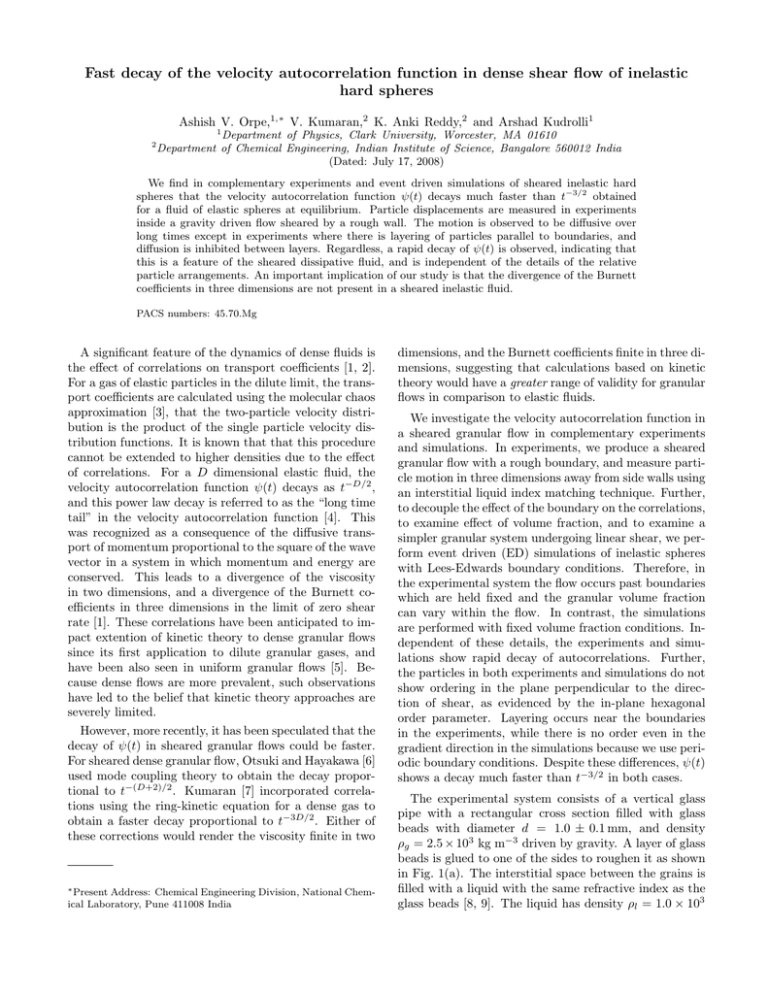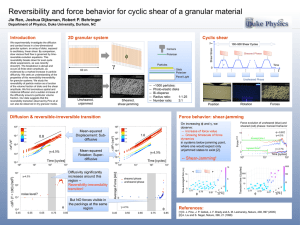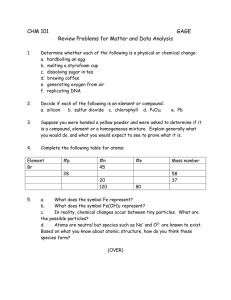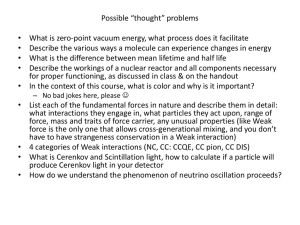Fast decay of the velocity autocorrelation function in dense
advertisement

Fast decay of the velocity autocorrelation function in dense shear flow of inelastic hard spheres Ashish V. Orpe,1,∗ V. Kumaran,2 K. Anki Reddy,2 and Arshad Kudrolli1 1 2 Department of Physics, Clark University, Worcester, MA 01610 Department of Chemical Engineering, Indian Institute of Science, Bangalore 560012 India (Dated: July 17, 2008) We find in complementary experiments and event driven simulations of sheared inelastic hard spheres that the velocity autocorrelation function ψ(t) decays much faster than t−3/2 obtained for a fluid of elastic spheres at equilibrium. Particle displacements are measured in experiments inside a gravity driven flow sheared by a rough wall. The motion is observed to be diffusive over long times except in experiments where there is layering of particles parallel to boundaries, and diffusion is inhibited between layers. Regardless, a rapid decay of ψ(t) is observed, indicating that this is a feature of the sheared dissipative fluid, and is independent of the details of the relative particle arrangements. An important implication of our study is that the divergence of the Burnett coefficients in three dimensions are not present in a sheared inelastic fluid. PACS numbers: 45.70.Mg A significant feature of the dynamics of dense fluids is the effect of correlations on transport coefficients [1, 2]. For a gas of elastic particles in the dilute limit, the transport coefficients are calculated using the molecular chaos approximation [3], that the two-particle velocity distribution is the product of the single particle velocity distribution functions. It is known that that this procedure cannot be extended to higher densities due to the effect of correlations. For a D dimensional elastic fluid, the velocity autocorrelation function ψ(t) decays as t−D/2 , and this power law decay is referred to as the “long time tail” in the velocity autocorrelation function [4]. This was recognized as a consequence of the diffusive transport of momentum proportional to the square of the wave vector in a system in which momentum and energy are conserved. This leads to a divergence of the viscosity in two dimensions, and a divergence of the Burnett coefficients in three dimensions in the limit of zero shear rate [1]. These correlations have been anticipated to impact extention of kinetic theory to dense granular flows since its first application to dilute granular gases, and have been also seen in uniform granular flows [5]. Because dense flows are more prevalent, such observations have led to the belief that kinetic theory approaches are severely limited. However, more recently, it has been speculated that the decay of ψ(t) in sheared granular flows could be faster. For sheared dense granular flow, Otsuki and Hayakawa [6] used mode coupling theory to obtain the decay proportional to t−(D+2)/2 . Kumaran [7] incorporated correlations using the ring-kinetic equation for a dense gas to obtain a faster decay proportional to t−3D/2 . Either of these corrections would render the viscosity finite in two ∗ Present Address: Chemical Engineering Division, National Chemical Laboratory, Pune 411008 India dimensions, and the Burnett coefficients finite in three dimensions, suggesting that calculations based on kinetic theory would have a greater range of validity for granular flows in comparison to elastic fluids. We investigate the velocity autocorrelation function in a sheared granular flow in complementary experiments and simulations. In experiments, we produce a sheared granular flow with a rough boundary, and measure particle motion in three dimensions away from side walls using an interstitial liquid index matching technique. Further, to decouple the effect of the boundary on the correlations, to examine effect of volume fraction, and to examine a simpler granular system undergoing linear shear, we perform event driven (ED) simulations of inelastic spheres with Lees-Edwards boundary conditions. Therefore, in the experimental system the flow occurs past boundaries which are held fixed and the granular volume fraction can vary within the flow. In contrast, the simulations are performed with fixed volume fraction conditions. Independent of these details, the experiments and simulations show rapid decay of autocorrelations. Further, the particles in both experiments and simulations do not show ordering in the plane perpendicular to the direction of shear, as evidenced by the in-plane hexagonal order parameter. Layering occurs near the boundaries in the experiments, while there is no order even in the gradient direction in the simulations because we use periodic boundary conditions. Despite these differences, ψ(t) shows a decay much faster than t−3/2 in both cases. The experimental system consists of a vertical glass pipe with a rectangular cross section filled with glass beads with diameter d = 1.0 ± 0.1 mm, and density ρg = 2.5 × 103 kg m−3 driven by gravity. A layer of glass beads is glued to one of the sides to roughen it as shown in Fig. 1(a). The interstitial space between the grains is filled with a liquid with the same refractive index as the glass beads [8, 9]. The liquid has density ρl = 1.0 × 103 2 13 d 60 d 150 d z x y (b) Laser Sheet (c) (a) glass beads (d) FIG. 1: (a) Schematic diagram of the granular flow cell used in the experiments. A layer of glass beads is glued to the right side wall in order to roughen it. The observation area is indicated by the dashed box. (b) The mean velocity and the strain rate γ̇ across the shear plane. (c) The number of particles per unit volume across the shear plane shows layering near the side walls. kg m−3 , and viscosity ν = 2.2 × 10−2 kg m−1 s. A dye added to the liquid is illuminated by a light sheet and imaged from an orthogonal direction. Thus the particles appear dark against a bright background, and a centroid algorithm is used to find the position of the particles to within a twentieth of a particle diameter. By switching the light and image planes, we can measure the particle motion in the shear and in the vorticity planes. Figure 1(b) shows the measured mean flow velocity < vx > as a function of horizontal distance y in the shear plane. To minimize the effect of the front and back walls, the data is obtained for 20d < z < 40d. The rough boundary is observed to slow the flow compared to the smooth boundary. At these measured velocities, the Reynolds number Re = vx d/ν is about 10−2 , and the ratio of the viscous drag of the grain to the gravitational force is estimated to be less than 10−2 . The strain rate γ̇ is shown in Fig. 1(b) as well. The maximum strain rate 0.25s−1 , is comparable in magnitude to a previous granular shear study [9] where the drag friction experienced by the boundary was measurably unaffected by the presence of the same interstitial liquid. Thus we conclude that the lubrication forces between grains do not affect the grain motion in the region where we discuss the correlation properties. The side walls also impose layering as can be observed from the oscillations in the plot of number of particles in a volume d3 plotted across the horizontal crossection in Fig. 1(c). The oscillations decrease with distance from the boundaries, and can be used to measure any influence of grain order on correlations. By taking the average of nφ d−3 and multiplying by the volume of sphere, we obtain that the average vol- ume fraction of the grains φ in the observation window is 0.59. ED simulations are performed in a three dimensional box with 500 smooth inelastic spheres of diameter d subjected to a rate of deformation field G = γ̇ex ey . The co-ordinate system is similar to that in the experiments, and the flow is in the x direction, the velocity gradient in the y direction and the z co-ordinate is perpendicular to the flow plane. The box size is adjusted to obtain the desired volume fraction. Simulations in three dimensions at large volume fractions (upto 0.6) and with coefficient of restitution as low as 0.7 have been carried out using the ED method by several authors [10]. In the ED procedure, particle trajectories are extrapolated forward in time and the earliest possible collision is identified. All particle positions are advanced by this time interval, and the postcollisional velocity of the colliding particles is updated along the line joining centers of the particles with a factor −en times the pre-collisional relative velocity, where en is the coefficient of restitution. The simulations were initiated with the particles arranged in an FCC lattice, and with velocities chosen from a random distribution with variance 1. The simulation was first allowed to proceed for 2 × 104 collisions per particle in order to reach a steady state, and the averaging was carried out over another 2 × 105 collisions per particle. Shear flow is imposed using Lees-Edwards periodic boundary conditions. More details on the simulation methods can be found in Ref. [11]. For an inelastic fluid under shear, the strain rate γ̇ and the ‘granular temperature’ T (mean square of the fluctuating velocities of the particles) are related through the energy balance condition, that the rate of shear production and inelastic dissipation of energy of the particles are equal at steady state. We carry out simulations with smooth spheres with en = 0.9, and with the volume fraction up to (φ = 0.59). For these parameters, we have taken care to ensure that there is no inelastic collapse [12], and there are no particle overlaps due to repeated collisions between particles. In addition, we have verified from the profiles of the volume fraction and mean velocity that there is no clustering instability[13] for the system sizes and volume fractions considered here. In order to contrast our results to the equilibrium case, simulations are also performed with elastic particles in the absence of applied shear at the same volume fractions. Figure 2(a) shows ψ(t) defined as, ψij (t) = h∆ui (t)∆uj (0)i h∆ui (0)∆uj (0)i (1) where ∆u is the fluctuating velocity of the particles, and i and j correspond to the coordinates. ψ(t) corresponding to the experiments shown in Fig. 2(a), is measured by calculating ∆u from the displacement of the particle over a time interval over which the mean flow travels a distance of 0.1d at that location. ψ(t) clearly decays rapidly over a time scale less than 1/γ̇. It is also observed 3 ψ(t) 1 0.1 (a) 0.01 0.001 0.01 1 ψ(t) . 0.1 1 -1 γ = 0.12 s . -1 γ = 0.05 s . -1 γ = 0.02 s .γ = 0.002 s-1 0.1 . γ t/d 3/2 9/2 (b) 0.01 0.01 0.1 1 vx∆t/d 1 ψ(t) 0.1 3/2 0.01 0.001 (c) 0.0001 0.001 0.01 0.1 1 10 1/2 tT /d FIG. 2: (a) Velocity auto-correlations function ψii versus time scaled with strain rate obtained from the experiments. (i = x − ¤, y − ◦, z − ¦). ψii is observed to become more isotropic (right to left) as one moves away from the shearing wall where particles form layers. (b) ψ(t) measured in the experiment decay faster in sheared flow (open symbol) compared with unsheared flows at various flow rates in Ref. [5] (filled symbol). (c) ψ(t) obtained from simulations with sheared inelastic spheres (symbols: φ = 0.50 − ◦, 0.56 − ¤, 0.59 − ¦) and elastic spheres at equilibrium for the same φ (lines: φ = 0.50− grey/blue, 0.56− dashed/red, 0.59− solid/black). ψ(t) for sheared inelastic spheres decays faster than t−3/2 . that ψyy decreases more rapidly in the boundary regions where particles are layered. ψ(t) would collapse on to one curve if T was uniform in the system. Because there is an energy current in the experiments, and T is not exactly proportional to γ̇ 2 , multiple curves are observed. Next, in order to contrast with correlations observed in unsheared granular flows, we replot ψ(t) for the sheared case with the corresponding ψ(t) for uniform (unsheared) granular flow obtained at various flow rates published previously in Ref. [5]. Here, we have averaged over the x and z directions to obtain smoother curves because ψ(t) appears to be isotropic in the vorticity plane. Scaled this way, ψ(t) collapse on to two sets of curves depending on the presence or absence of shear[15]. A fact, obscured somewhat by the use of the log scale, is that in case of the unsheared case, ψ(t) crosses zero and becomes negative before decaying to zero. Clearly, ψ(t) for the sheared case decays differently and faster to zero than t−3/2 . While a line with slope −9/2 is drawn to guide the eye, the range over which ψ(t) can be measured does not allow us to draw any firm conclusions on the scaling of the decay [6, 7]. In Fig. 2(c), ψ(t) obtained from simulations of inelastic sheared spheres with en = 0.9 is shown, along with simulations of elastic spheres at the same φ. Decay proportional to t−3/2 is clearly observed for low volume fractions φ = 0.2, which is not shown in Fig. 2(c) to increase clarity. For φ = 0.4 and higher, it is well known that there is a reversal in the sign of ψ(t) from positive to negative at a finite time, due to the reversal in the velocity of the particle trapped in the cage between its neighbors. The time for this reversal decreases as φ increases (as can be noted from the shift of the negative peak in Fig. 2(c)), due to a decrease in the dimensions of the cage formed by the neighboring particles. However, the absolute value of ψ(t) still shows a power law decay proportional to t−3/2 in the long time limit. By contrast, the sheared simulation data does not show this reversal and shows a fast time decay for all φ. Interestingly, it may be noted that ψ(t) in the three directions are almost equal to each other except when layering is important. To examine any link between orientational order and ψ(t), we examine the two dimensional orientational order parameter q6 =< exp (i6θp ) >, where < . > is the average over all nearest neighbor bonds and θp is the angle between particle bonds. For disordered packing, q6 = 0. Evaluating q6 for the experimental data in the vorticity plane, we find that q6 decreases from about 0.075 near the side walls to less than 0.03, a few grain diameters away from the side wall, indicating disordered packing. q6 in the shear plane is observed to be ∼ 0.1 but still significantly smaller than q6 = 1 for hexagonal order. q6 obtained from the simulations, both in the vorticity plane and the shear plane, is also observed to be less than 0.03, indicating that there is no hexagonal ordering. However, the state of order appears to be linked to particle diffusion in a shear flow of inelastic particles, as quantified by the mean square displacement (MSD) of the particles (see Fig. 3.) To calculate MSD in a shear flow, one has to take into account the affine deformation of the flow (sometimes also refereed to as Taylor dispersion [14].) Therefore, h(∆x)2 i = h(x(t) − xa (t))2 i, h(∆y)2 i = h(y(t)−y(0))2 i, and h(∆z)2 i = h(z(t)−z(0))2 i, where xa (t), corresponds to the affine deformation of the shear flow. After accounting for this contribution, we find that slope approaches 1 over long times in the vorticity and the flow directions, showing that the diffusion constants scale with strain rate. However in the gradient direction, MSD in the experiments appear to grow sub-diffusively and particles even appeared trapped in a layer over the observation window. This effect is most pronounced in the region next to the side wall, and the slope only appears to approach 1, as one examines regions away from the side walls. Because of the Lees-Edwards 2 <(∆y) /d 2 2 <(∆z) >/d 2 2 <(∆x) >/d 2 4 100 10 1 0.1 0.01 0.001 0.0001 100 10 1 0.1 0.01 0.001 0.0001 100 10 1 0.1 0.01 0.001 0.0001 (a) . -1 γ = 0.12 s . -1 γ = 0.05 s . -1 γ = 0.02 s .γ = 0.002 s-1 (b) (c) 0.001 0.01 0.1 . 1 10 100 γ t/d FIG. 3: The scaled mean square displacements (MSD) in (a) the flow direction, (b) the vorticity direction, and (c) the shear direction in the experiments (symbols) and the simulations (solid line) for various strain rates as a function of the scaled time tγ̇. The contribution of the affine deformation of the flow has been subtracted from the displacements (see text). The dashed line corresponds to a slope of 1. boundary conditions used in the simulations, there is no layering, and a clear crossover to diffusive behavior is observed even in the gradient direction for γ̇t/d > 1. Therefore, it appears that the rapid decay of ψ(t) is not related to the sub-diffusive nature of the MSD (caging effect), but appears to be present independent of the state of order and the diffusive/sub-diffusive nature of particle motion. These results clearly show that the velocity autocorrelation function decays much faster than the t−3/2 decay for a fluid of elastic particles both in the presence and absence of ordering, indicating that it seems to be an inherent property of a dissipative sheared system. Finally, we argue that even though the experiments are done with particles immersed in a fluid, the very small ratio of the viscous and the gravitational forces means than the momentum is essentially transfered between particles during contact and very little is transferred to the interstitial fluid just as in dry granular matter colliding in air. Therefore, we anticipate that the analysis performed with ring-kinetic approach [7] carry over because momentum is conserved and energy is dissipated except perhaps in the short time limit depending on the details of the interaction. In summary, we have shown that the decay of the velocity autocorrelation function in a sheared granular flow is qualitatively different from that in an elastic fluid at equilibrium. Our results cannot verify the scaling laws [6, 7], because one would need to track the decay in the autocorrelation function over more than two to four orders of magnitude for one magnitude of increase in the time. However, the fast decay in the velocity autocorrelation function indicates that the dynamics in a sheared granular flow is different from that in an elastic fluid at equilibrium. Specifically, the divergences in the transport coefficients due to long time tails in the autocorrelation functions may not be present in a sheared inelastic fluid. This raises the prospect that kinetic theory calculations may be applicable for a larger range of volume fractions than equivalent theories for fluids of elastic particles. Therefore, constitutive relations based on kinetic theory for granular flows may not be restricted to the dilute limit, as previously thought, but may be applicable even at higher volume fractions. This work was supported by the National Science Foundation under Grant Nos. CTS-0334587, DMR0605664 and the J.C. Bose Fellowship, DST, Government of India. [1] M.H. Ernst, B. Cichocki, J.R. Dorfman, J. Sharma, & H. van Beijeren, J. Stat. Phys., 18, 237 (1978). [2] K. Kawasaki and J. Gunton, Phys. Rev. A 8, 2048, (1973). [3] S. Chapman and T.G. Cowling, The Mathematical Theory of Non-Uniform Gases, Cambridge University Press, 1970. [4] B. Alder and A.W. Wainwright, Phys. Rev. A 1, 18, (1970). [5] A.V. Orpe and A. Kudrolli, Phys. Rev. Lett. 98, 238001 (2007). [6] M. Otsuki and H. Hayakawa, cond-mat arXiv:0711.1421. [7] V. Kumaran, Phys. Rev. Lett., 96, 258002, (2006). [8] J.-C. Tsai, G.A. Voth, and J.P. Gollub, Phys. Rev. Lett. 91, 064301 (2003). [9] S. Siavoshi, A.V. Orpe, and A. Kudrolli, Phys. Rev. E 73, 010301 (2006). [10] N. Mitarai and H. Nakanashi, Phys. Rev. E, 031305, (2007); C.S. Campbell, J. Fluid Mech. 348, 85 (1997). [11] V. Kumaran, submitted to J. Fluid Mech. [12] M. Alam and C. M. Hrenya, Phys. Rev. E, 63, 061308, (2001). [13] M.A. Hopkins and M.-Y. Louge, Phys. Fluids A, 3, 47 (1991). [14] B. Utter and R. P. Behringer, Phys. Rev. E 69, 031308 (2004). [15] It may be more natural to scale with the square root of the granular temperature, but at such high densities, it is impossible to obtain instantaneous velocities of particles in the experiment.




